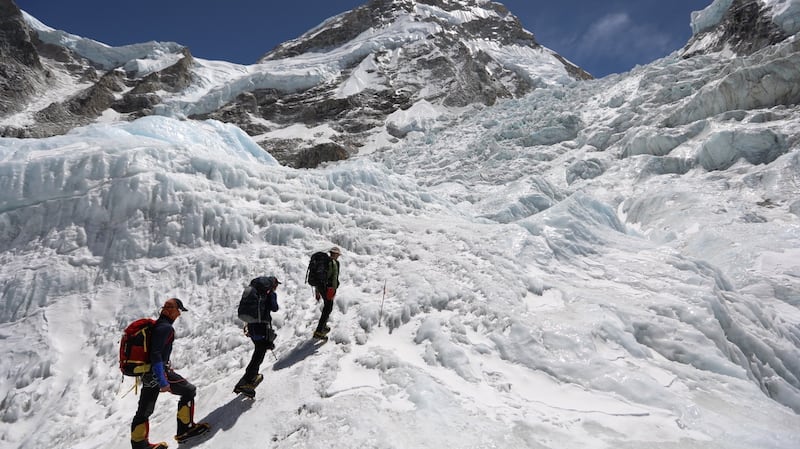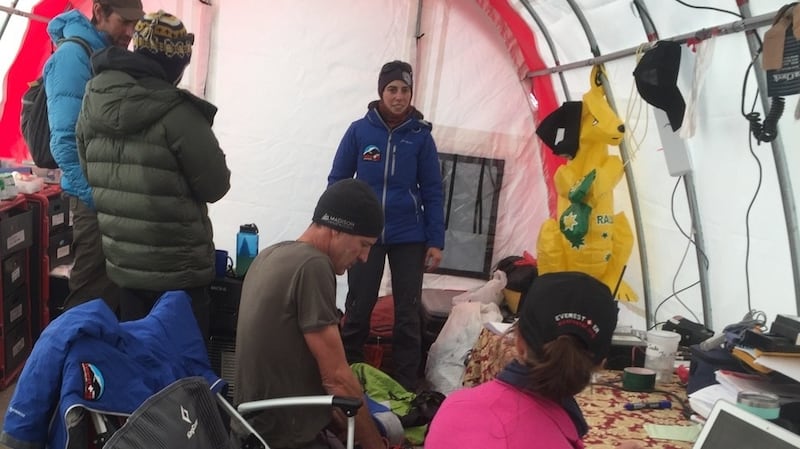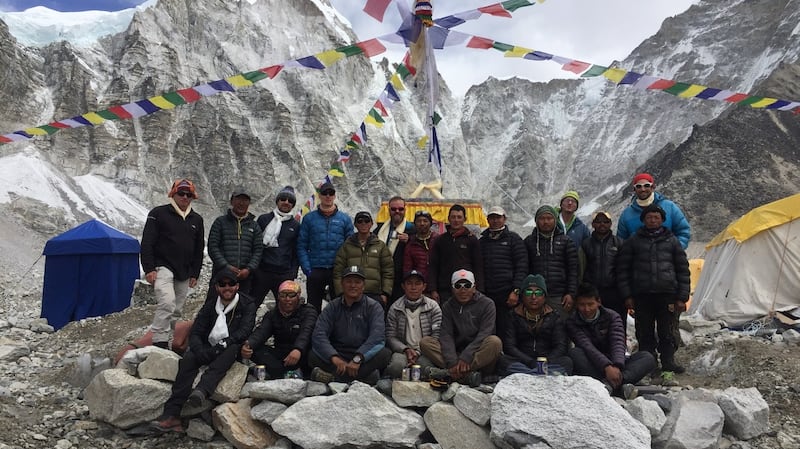I’m lying in my tent, sometimes snoozing, other times writing. It’s pleasant right now, with the afternoon sun beating down. The occasional sound of rock or ice fall from one of the surrounding mountain faces is now familiar. There is a faint sound of a helicopter dropping off or picking up someone at one of the distant helipads. We had some strong winds earlier in the week, but now it is calm.
We’ve been at Everest Base Camp (EBC) for nearly a week and we’re ready to get moving up the mountain. We’ve had our expedition blessed by a local monk, ventured out on a couple of hikes, been into the Khumbu Icefall and practised key skills to ensure that we move efficiently up the mountain.

Our bodies are continuing to acclimatise well. Over the last few nights my sleep has been relatively uninterrupted. The headaches are a distant memory. It’s time to climb higher and feel uncomfortable again.
By all accounts it looks like a record year on the mountain. The Himalayan Times out of Kathmandu reports that 385 climbers have permits for Everest from the Nepalese side, compared to 289 last year, and that more than 100 climbers are preparing to ascend the neighbouring peak of Lhotse, which shares much of our route up to Camp III at 7,200m. It's going to be busy.
We’ve met some interesting teams on the mountain already, including the Gurkha team (which has 21 permits), the Indian paratrooper/special forces team (which has 14 permits), and a few of the larger international teams, including Adventure Consultants and Madison Mountaineering.
Earlier this week, professional photographer Steve Brown and I went to meet with the icefall doctors and to visit the Everest base camp emergency room. The icefall doctors, as they are known, are amongst the coolest individuals we've met in Nepal. Working for the Sagarmatha Pollution and Control Committee (SPCC), they are a team of eight highly skilled mountaineers supported by two cook staff. Sagarmatha ('Godess of the Universe') is the Nepalese name for Everest. The icefall doctors are responsible for creating and maintaining a safe route through the complex and constantly changing terrain of the icefall up to Camp I.

The icefall doctors arrived at EBC on March 7th and it took them two weeks to prepare the route. Throughout the season, two of them travel through the icefall each day, inspecting the route, ropes, and ladders. This year they’ve used 6,000m of rope and 26 ladders to fix the initial route up to Camp I. In some cases, they have to fix more than one ladder together to cross a crevasse or go up a serac (vertical icewall). Since they fixed the original route there has been only one significant serac fall which required material reworking of the route. Thankfully, no one was harmed.
Typically, Sherpa and climbers alike will wake up in the early hours to negotiate the hazardous terrain of the Khumbu Icefall in the cool of morning, before the ice starts to melt and weaken. Serac falls mostly occur in the late afternoon.
Later in the day I talk over tea with SPCC base camp manager Tshering Tenzing Sherpa and his team about the dangers and excitement of the role. The icefall doctors are keen to convey how much they love their jobs. It is also clear they have an elevated status in their villages because of their work.
Crevasse fall
Despite the high-profile dangers of the role, in Tshering’s nine years in charge he’s proud of his safety record. That record contains a single blemish: the death of a colleague in a crevasse fall in 2013. In 2015, when the avalanche swept through the icefall, killing 14 Sherpa who were taking loads up to Camp I and II, the icefall doctors were all safe at base camp. They immediately jumped into action as rescue workers, first rebuilding the route to get to those in trouble and then helping survivors and recovering bodies.
The Everest emergency room doctors work just up the hill from the icefall doctors and have a nice brand-new tent. In 2015, their camp had stood at the site that was at the heart of the devastation at base camp when the earthquake struck.
Meg Walmsley, a 34-year-old from Darwin, Australia, was there on that day. She recalls how she and her colleagues had to salvage from the wreckage of their camp what supplies they could to set up a makeshift field hospital at the IMG camp. There, she treated nearly a hundred patients in a small number of hours. Despite that intense experience, Meg was determined to return and is back this year. There are two other doctors here for the season, Mária Nemethy from Salt Lake City and Sanjeeb Bhandari from Kathmandu. Mária spoke about being inspired by practising medicine in a resource-limited environment.
The fourth and final member of the ER contingent is Lakpa Sherpa, head of logistics and a long-line helicopter rescue specialist. He is also the base camp wifi card salesman, which perhaps makes him the most sought-after individual on the hill. When not selling wifi, Lakpa will be the man attached to the end of the line when a helicopter comes in for high-altitude mountain rescues.
I had initially sought out Lakpa to discuss the fact I had purchased $100 worth of wifi cards which weren't working, but we quickly shifted conversation to high-altitude rescues. Lakpa has been on Everest every year since 2003 and has been instrumental in over 50 helicopter rescue and recovery operations. In 2013 he took part in a record-breaking highest-altitude helicopter rescue at 7,800m. A Nepali-Canadian climber had got into difficulties above 8,500m, before being rescued by a Sherpa team and brought to 7,800m, where Italian helicopter pilot and alpinist Simone Moro took up the chopper. The rescue was nearly 1,000m higher than any previous successful effort.
High winds
The ER team will get busy. The season has only just started and they’ve already sent down a number of Everest hopefuls, mainly with suspected HAPE (high altitude pulmonary edema). It’s great to know Meg, Mária, Sanjeeb, and Lapka are around. I just hope I won’t have to visit them again under more serious circumstances.
Following high winds earlier in the week, we have finally made it into the Khumbu Icefall for a “recce” and some skills training over the past few days. We got on our 8,000m mountain boots, harnesses, helmets, crampons (the two-inch metal spikes we need to attach to our boots for the ice and snow) and practiced with jumars (devices that allow climbers to safely pull themselves up fixed ropes) and figure-8s. We did abseiling and crossed vertical and horizontal ladders while clipped into ropes and carrying loads. The Khumbu Icefall is a legendary Everest feature and, despite its well-publicised hazards, we were all very excited to be entering this phase.
The day before I write this, we had our Puja ceremony. Nawag Renje Sherpa, a monk from the village of Pangboche who had completed the full-day walk up the valley the previous day for another ceremony and had spent the night in a tent in our camp, led the ceremony.

The Sherpa in our team had been busily making an impressive altar from loose rocks over the previous day. As the ceremony began, offerings were put all around: from rice and barley to coca cola, chocolate, rum and beer. We were encouraged to bring our key climbing gear – crampons, ice axe, harness, helmet – to place next to the altar to be blessed as well.
As the ceremony began, drums accompanied the monk’s chanting, and first we had tea, then chang (Sherpa rice alcohol), beer, and shots of rum. The colourful prayer flags were then raised and we received our individual blessings and gave our small donations.
The blessing is very important for our climbing Sherpa, and central to our expedition. This was one of the first times we had the opportunity to meet them all and we were in awe of their achievements. There are 39 successful summits from our Sherpa team, including Dorje Gyeljen Sherpa, who has summited 12 times; Kaljang Dorje Sherpa (10); Cewang Jabju Bhote (11); Pemba Dorje (4); and Dawa and Pemba with one successful summit each.
Injured both ankles
By lunchtime the blessing for the expedition was complete, but a hastily organised helicopter was touching down just 25 metres from my tent. Having started with four for Everest and two for Lhotse, we are unfortunately now down to three for Everest. Blake Penson, who had narrowly escaped the worst of the 2015 earthquake, had injured both of his ankles. Despite a few days' rest, the prognosis was that the trip was over for him. We wished him well. I couldn't imagine worse terrain for an injured ankle than EBC – a mix of loose rock on ever-melting and ever-changing glacier conditions. Not a smooth surface in sight.
Tomorrow we’ll be waking up at 2.30am and heading up through the icefall to Camp I at 6,000m. It should take us somewhere between four and eight hours the first time through, depending on our breathing and energy levels and if it is busy with other climbing teams going up and down.
We expect to start feeling uncomfortable again with the new elevation and likely will stay at Camp I for one or two nights, before heading up to Camp II at 6,400m. This rotation is all about preparing our bodies to go higher. At Camp I we’ll spend a lot of time lying in our tents, melting snow to drink, playing cards, reading books and chatting.
Camp II is where we’ll be spending more time later in the expedition and our facilities there will include a mess tent with a heater and a full-time cook staff. The headaches will probably return. Staying rested and well hydrated is key to a comfortable stay.
Rory McHugh is climbing Everest in aid of Rory's Nepal School Project with Child Rescue Nepal, to build schools in off-the-beaten track villages that have yet to recover from the 2015 earthquake. He would greatly appreciate your support on virginmoneygiving.com/letsbuildschools on rorymchugh.com and @realrorymchugh
You can also follow his daily progress all the way to the summit through the Garmin mapping site: share.garmin.com/roryeverest












